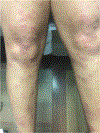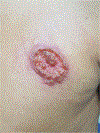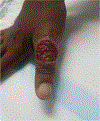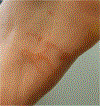Common Dermatologic Conditions in Returning Travelers
- PMID: 34458071
- PMCID: PMC8389143
- DOI: 10.1007/s40475-021-00231-8
Common Dermatologic Conditions in Returning Travelers
Abstract
Purpose of review: Travel medicine practitioners often are confronted with returning travelers with dermatologic disorders that could be of infectious causes or inflammatory or allergic. Some dermatologic processes are the result of exposure to insects or acquired due to environmental exposures. There is a broad range of dermatosis of infectious and non-infectious etiologies that clinicians need to consider in the differential diagnosis of dermatosis in travelers.
Recent findings: With increasing international travel to tropical destinations, many individuals may be exposed to rickettsia (i.e., African tick bite fever, scrub typhus, or Mediterranean spotted fever), parasitic infections (i.e., cutaneous larva migrans, cutaneous leishmaniasis, African trypanosomiasis, or American trypanosomiasis), viral infections (i.e., measles or Zika virus infection), bacterial (i.e., Buruli ulcer) or ectoparasites (scabies or tungiasis), and myiasis. Cutaneous lesions provide clinical clues to the diagnosis of specific exposures during travel among returned travelers.
Summary: Dermatologic disorders represent the third most common health problem in returned travelers, after gastrointestinal and respiratory illness. Many of these conditions may pose a risk of severe complications if there is any delay in diagnosis. Therefore, clinicians caring for travelers need to become familiar with the most frequent infectious and non-infectious skin disorders in travelers.
Keywords: Cutaneous Larva Migrans; Dermatologic; Leishmaniasis; Myiasis; Phytophotodermatitis; Prurigo Nodularis; Travelers; Tungiasis.
Conflict of interest statement
Conflict of Interest All authors declare that they have no conflict of interest.
Figures










References
-
- Hochedez P, Caumes E. Common skin infections in travelers. J Travel Med. 2008;15(4):252–62 - PubMed
-
This is a classic article written by dermatologist with extensive experience and expertise in travel medicine which provides a detailed description of dermatologic conditions in travelers.
-
- Wilson ME, Chen LH. Dermatologic infectious diseases in international travelers. Curr Infect Dis Rep. 2004;6:54–62 - PubMed
-
In depth narrative review of dermatologic conditions in travelers.
Grants and funding
LinkOut - more resources
Full Text Sources
Research Materials
